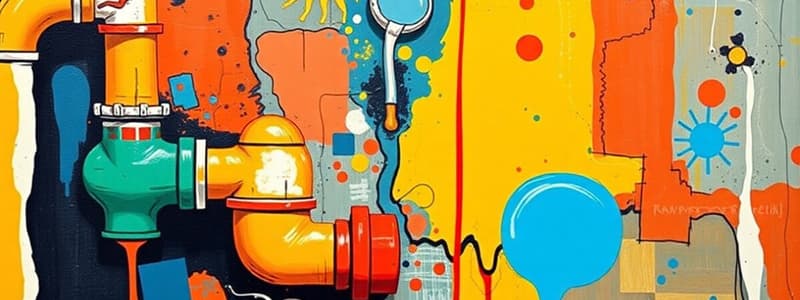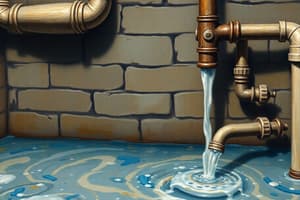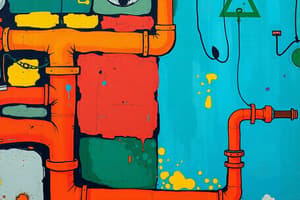Podcast
Questions and Answers
What is plumbing?
What is plumbing?
The art and technique of installing pipes, fixtures, and other apparatuses in buildings for bringing in the supply of liquids and removing wastes.
The Plumbing Trade was recognized by the Philippine government in 1902.
The Plumbing Trade was recognized by the Philippine government in 1902.
True (A)
Who became the first Chief of the Division of Plumbing Construction and Inspection?
Who became the first Chief of the Division of Plumbing Construction and Inspection?
- Joseph Estrada
- Ramon Magsaysay
- John F. Haas (correct)
- Malacañang
What year did the National Master Plumbers Association of the Philippines get formally organized?
What year did the National Master Plumbers Association of the Philippines get formally organized?
What law became known as the Plumbing Law of the Philippines?
What law became known as the Plumbing Law of the Philippines?
Match the following principles with their descriptions:
Match the following principles with their descriptions:
All premises intended for human use shall be provided with a supply of ___ water.
All premises intended for human use shall be provided with a supply of ___ water.
Every building is required to connect its plumbing fixtures to the sewer system if it abuts a public sewer.
Every building is required to connect its plumbing fixtures to the sewer system if it abuts a public sewer.
What is the minimum requirement for plumbing fixtures in each family dwelling unit?
What is the minimum requirement for plumbing fixtures in each family dwelling unit?
Flashcards are hidden until you start studying
Study Notes
Plumbing Definition
- The art and technique of installing pipes, fixtures, and other apparatuses in buildings for bringing in the supply of liquids, substances, and/or ingredients.
- The system is also responsible for removing water, liquid, and other carried wastes hazardous to health, sanitation, life, and property.
- Includes the pipes and fixtures after installation, collectively known as the 'plumbing system'.
Plumbing History
- Recognized officially in Manila, Philippines in 1902.
- First Chief of the Division of Plumbing Construction and Inspection was Master Plumber John F. Haas.
- The "Plumbing Code for the City of Manila" (Manila City Ordinance 2411) was enacted and placed under the Department of Public Services.
- The National Master Plumbers Association of the Philippines (NAMPAP) was organized in 1935.
- In 1954, the Third Congress approved House Bill No. 962, which became R.A. 1378 “Plumbing Law of the Philippines”.
- The National Plumbing Code of the Philippines was prepared by NAMPAP and approved by Malacañang in 1959.
- The"Building Code of the Philippines" was passed in 1972, incorporating the “National Plumbing Code of 1959” as a referral code.
- The Professional Regulation Commission (PRC) adopted the Revised Plumbing Code of 1999.
Basic Plumbing Code Principles
- Premises intended for human use should have a supply of pure and wholesome water, not connected to unsafe water supply, backflow, or back-siphonage.
- Plumbing fixtures, devices, and appurtenances shall be supplied with sufficient water volume and pressure to function without undue noise.
- Plumbing should minimize water usage while maintaining proper performance and cleaning.
- Devices used to heat and store water should be designed and installed to prevent dangers from explosion through overheating.
- Buildings abutting on streets, alleys, or easements with public sewers should connect their plumbing fixtures to the sewer system.
- Each dwelling unit should have at least one water closet, a kitchen sink, a lavatory, and either a bathtub or shower to meet basic sanitation and hygiene requirements.
- Plumbing fixtures should be made of smooth, non-absorbent material, free from concealed fouling surfaces and located in ventilated enclosures.
- The drainage system should be designed, constructed, and maintained to safeguard against fouling, deposit of solids, clogging, and with adequate cleanouts for easy cleaning.
- All piping should be made of durable, approved materials, free from defective workmanship.
- Each fixture directly connected to the drainage system should be equipped with a water-sealed trap.
- The drainage pipe system should be designed to provide adequate air circulation.
- Vent terminals should extend to the outer air and be installed to prevent clogging and the return of foul air to the building.
- Plumbing systems should be tested to identify any leaks or defects.
- Substance that could clog pipes or damage components should not be allowed to enter the building drainage system.
- Protection should be provided to prevent contamination of food, water, sterile goods, etc., by backflow of sewage.
- Water closets should be located in properly lighted and ventilated rooms.
Studying That Suits You
Use AI to generate personalized quizzes and flashcards to suit your learning preferences.




